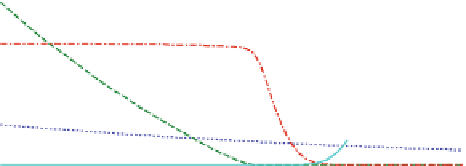Environmental Engineering Reference
In-Depth Information
8
concentration
7
C
org
O
2
NO
2
Mn
6
5
4
3
2
1
0
0
20
40
60
80
100
distance
Fig. 9.6 Result of MATLAB
example for the redox sequence example
®
of organic matter. Following van Capellen and Wang (1995), the factor
f
i
takes
a form that is similar to Monod kinetics:
!
X
i
1
c
i
c
i
c
lim
;i
f
i
¼
1
f
j
(9.23)
j¼
1
where a limit concentration
c
lim,
i
appears, which is specific to components. The
term in the brackets ensures that the sum of all contributions does not exceed 1. All
six major redox processes are thus implemented in the model: organic respiration,
denitrification, manganese-, iron- and sulphate reduction and methanogenesis.
More details of the model are given by Holzbecher et al
.
(
2001
). The graphical
output of the program is depicted in Fig.
9.6
.
References
Berner RA (1964) An idealized model of dissolved sulphate distribution in recent sediments.
Geochim Cosmochim Acta 28:1197-1503
Berner RA (1971) Principles of chemical sedimentology. McGraw-Hill, New York, p 240
Boudreau BP, Westrich JT (1984) The dependence of bacterial sulphate reduction on sulphate
concentration in marine sediments. Geochim Cosmochim Acta 48:2503-2516
Cai W-J, Sayles FL (1996) Oxygen penetration depths and fluxes in marine sediments. Marine
Geochemistry 52:123-131
Deaton ML, Winebrake JI (2000) Dynamic modeling of environmental systems. Springer,
New York, p 194




































































